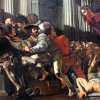In his book The Legalized Crime of Banking, Silas Walter Adams exposes the intricate web of deceit and corruption embedded in the Federal Reserve banking system. Drawing from historical examples and constitutional references, Adams argues that the power of money creation was usurped by private bankers, plunging the economy into an ever-deepening cycle of debt and inflation. His revelations align with Gottfried Feder’s critique of financial capitalism in early 20th-century Germany. Feder, a key economic thinker of his time, challenged the predatory nature of interest and debt, and despite being painted as radical, his ideas find a shocking resonance in Adams’ analysis.
The Creation of Money: How the Bankers Do It
One of the key aspects Adams exposes is the creation of money by banks out of thin air. He writes, “The Government does not create nor issue money. Banks create and issue all our money. Coins and currency are not money—just tokens. Our money is bank credit in the form of bank deposits”. This distinction between physical money and bank credit highlights how the financial elite control the lifeblood of the economy—credit—without producing any real value.
The ability to create money, Adams argues, is nothing more than a legalized form of theft. Banks do not lend money they physically have; instead, they create new credit every time a loan is issued. This method, according to Adams, has resulted in vast profits for banks at the expense of taxpayers. During World War II, for example, Adams writes that bankers profited by over $1 trillion, while the public and the government were left with massive debts.
Feder’s Struggle: Reassessing His Ideas in Light of Adams
Gottfried Feder, an economist in early Nazi Germany, has long been misrepresented as having “evil” ideas. His critique of financial capitalism, especially his opposition to “interest slavery,” now seems prophetic in light of Adams’ revelations. Feder’s assertion that financial capitalism, controlled by a small elite, was the true enemy of the people aligns with Adams’ view that bankers have made the working class and governments their slaves. As Feder pointed out, the people produce real goods and services, yet are perpetually indebted to a small banking elite. In today’s context, many of Feder’s views, while politically contentious, speak to a broader, globally relevant criticism of unregulated financial power.
Shocking Truths You Didn’t Know
Banks Don’t Lend Deposits: It’s widely believed that banks lend out the money deposited by customers, but Adams reveals this as a myth. He explains, “Banks do not lend cash, currency-coins, or bills. They do not lend their own capital, surplus, or profits. Not their depositors’ deposits; nor their own credit; nor the nation’s credit. Period. Bankers do not lend money or anything; they only buy notes, mortgages, bonds, and securities”.
The Federal Reserve Is Not Federal: Despite its name, the Federal Reserve is a private institution owned by the banks it serves. Adams and others have noted that the Federal Reserve system was designed to enrich its private owners while shackling the nation to perpetual debt.
The Constitutional Betrayal
Adams ties his critique back to the U.S. Constitution, pointing out that Article 1, Section 8 explicitly states that only Congress has the power to coin money. He argues that the Federal Reserve Act of 1913 was an unconstitutional transfer of this power to private corporations. He calls for a return of money creation to Congress, writing that “the Congress shall have the power to create our money and control the nation’s credit”.
Feder’s work similarly called for control of money and credit to be returned to the people, advocating for a system that would prevent the exploitation of workers through interest and debt. Both Adams and Feder agree that banking as it stands is not merely an economic system—it’s a system of control.
Time to Wake Up
As we reflect on the works of Silas Walter Adams and Gottfried Feder, it becomes clear that much of what we believe about banking and money is deeply flawed. The legalized crime of banking continues to harm everyday citizens, and it’s time for a serious reevaluation of who controls our money and credit. The shocking truths Adams exposes in The Legalized Crime of Banking should be a wake-up call for anyone who still believes the current system is fair or just.




